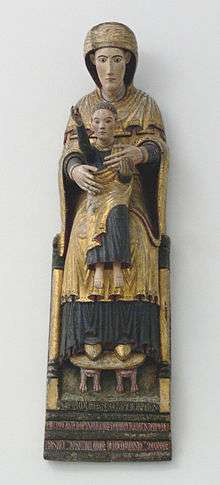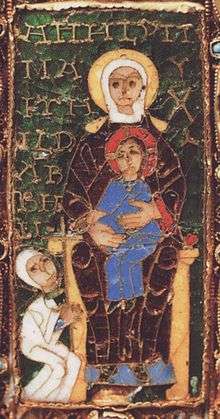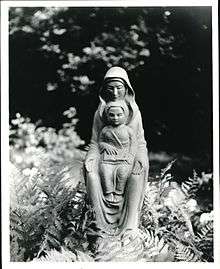Seat of Wisdom

In Roman Catholic tradition, "Seat of Wisdom" or "Throne of Wisdom" (translating Latin sedes sapientiae) is one of many devotional titles for Mary, the Mother of God. It refers to her status as the vessel in which the Holy Child was born. In "Seat of Wisdom" icons and sculptures, Mary is seated on a throne with the Christ Child on her lap. For the more domestic and intimate iconic representations of Mary with the infant Jesus on her lap, see Madonna and Child. The Roman Catholic Church honors Mary, Seat of Wisdom, with a feast day on June 8.
The title and the imagery associated with it are occasionally also found in Protestant tradition; for example Merton College, Oxford commissioned a statue of "Our Lady, Seat of Wisdom" for its chapel in 2014.[1]


History
This type of madonna image is based on the Byzantine prototype of the Chora tou Achoretou ("Container of the Uncontainable"),[2] an epithet mentioned in the Acathist Hymn and present in the Greek East by the early 11th century, when the Byzantine-inspired enamels were made in Germany for the Cross of Mathilde. The type appeared in a wide range of sculptural and, later, painted images in Western Europe, especially around 1200. In these representations, some structural elements of the throne invariably appear, even if only handholds and front legs. For hieratic purposes, the Virgin's feet often rest on a low stool. Later, Gothic sculptures of the type are more explicitly identifiable with the Throne of Solomon, where:
two lions stood, one at each hand. And twelve little lions stood upon the six steps on the one side and on the other.
The Sedes sapientiae icon also appeared in illuminated manuscripts and Romanesque frescoes and mosaics, and was represented on seals. The icon possesses in addition emblematic verbal components: the Virgin as the Throne of Wisdom is a trope of Damiani or Guibert de Nogent, based on their typological interpretation of the passage in the Books of Kings, that describes the throne of Solomon (I Kings 10: 18–20, repeated at II Chronicles 9: 17–19). This was much used in Early Netherlandish painting in works like the Lucca Madonna by Jan van Eyck.
Other uses
In modern times, sedes sapientiae is for example the motto of the Catholic University of Leuven (here a play on words, since the university itself is a major seat of learning in the Low Countries). In September 2000, at the close of the Jubilee Year, Pope John Paul II commissioned the Slovenian Jesuit artist Marko Ivan Rupnik to create in mosaic an icon of the Virgin sedes sapientiae for the world's Catholic universities; it has since been passed reverently among Catholic institutions in a number of nations.
See also
Further reading
- Hans Belting, 1994. Likeness and Presence: A History of the Image before the Era of Art, translator E. Jephcott (Chicago: University of Chicago Press)
- Ilene Forsyth, 1972. The throne of Wisdom: Wood Sculptures of the Madonna in Romanesque France. (Princeton: Princeton University Press)
- Lane, Barbara G,The Altar and the Altarpiece, Sacramental Themes in Early Netherlandish Painting, Harper & Row, 1984, ISBN 0-06-430133-8
References
- ↑ "Our Lady, Seat of Wisdom: New chapel statue is dedicated". www.merton.ox.ac.uk.
- ↑ "Ορθόδοξες φωτογραφίες και εικόνες - Εικόνες της Υπεραγίας Θεοτόκου / Icons of Most Holy Theotokos/ΠΑΝΑΓΙΑ η Χώρα του Αχωρήτου". Rel.gr. Retrieved 2014-08-22.
External links
![]()